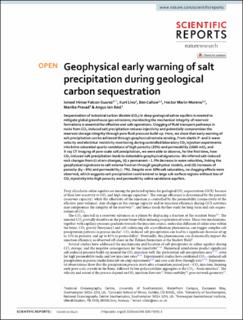Geophysical early warning of salt precipitation during geological carbon sequestration
Peer reviewed, Journal article
Published version
Permanent lenke
https://hdl.handle.net/11250/2681856Utgivelsesdato
2020Metadata
Vis full innførselSamlinger
- NGI articles [1026]
Sammendrag
Sequestration of industrial carbon dioxide ( CO 2) in deep geological saline aquifers is needed to mitigate global greenhouse gas emissions; monitoring the mechanical integrity of reservoir formations is essential for effective and safe operations. Clogging of fluid transport pathways in rocks from CO 2-induced salt precipitation reduces injectivity and potentially compromises the reservoir storage integrity through pore fluid pressure build-up. Here, we show that early warning of salt precipitation can be achieved through geophysical remote sensing. From elastic P- and S-wave velocity and electrical resistivity monitoring during controlled laboratory CO 2 injection experiments into brine-saturated quartz-sandstone of high porosity (29%) and permeability (1660 mD), and X-ray CT imaging of pore-scale salt precipitation, we were able to observe, for the first time, how CO 2-induced salt precipitation leads to detectable geophysical signatures. We inferred salt-induced rock changes from (i) strain changes, (ii) a permanent ~ 1.5% decrease in wave velocities, linking the geophysical signatures to salt volume fraction through geophysical models, and (iii) increases of porosity (by ~ 6%) and permeability (~ 7%). Despite over 10% salt saturation, no clogging effects were observed, which suggests salt precipitation could extend to large sub-surface regions without loss of CO 2 injectivity into high porosity and permeability saline sandstone aquifers.
